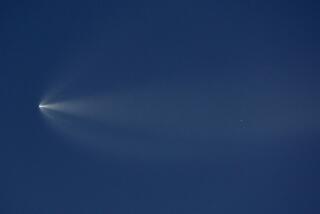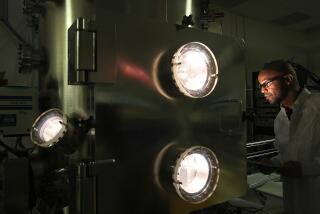Program Has American Rocket Co. Aiming High Again
- Share via
American Rocket Co., a Ventura firm that is developing a hybrid rocket motor, has taken another step in a long comeback following a failed rocket launch at Vandenberg Air Force Base that nearly destroyed the company in 1989.
The company heads a team that will receive $10.4 million from the Defense Department to build and launch an experimental space vehicle powered by American Rocket’s H-1800 engine. The engine combines solid and liquid fuels to generate 250,000 pounds of thrust. The hybrid engine offers significant economic and safety advantages over conventional power systems, contends Paul Estey, American Rocket’s president.
The award, part of the Clinton Administration’s campaign to convert defense technology to new commercial products, calls for American Rocket and its fellow team members, Martin Marietta Corp. and United Technologies Corp., to contribute an additional $11.8 million, bringing the project’s total cost to $22.2 million. Martin Marietta and United Technologies will concentrate on systems engineering for the space vehicle.
“This gives us a tremendous boost,” Estey said. “Aside from the financial impact, it means we’ve received an important vote of confidence from the government.”
Nationwide, 2,800 proposals have been made under the government’s defense-conversion program, but Estey said his firm’s proposal is one of only 162 selected thus far.
American Rocket’s unmanned suborbital spacecraft, called HyFlyer, is a project that the company hopes will lead to an orbiting vehicle that can be used for communications, weather forecasting, environmental monitoring and locating natural resources. Estey said the first rocket will be aloft for only about 10 minutes before coming down in the ocean.
Indicating that it may also have military applications, some personnel at Edwards and Vandenberg Air Force bases will work with the private concerns in developing HyFlyer.
The rocket is scheduled to be launched in March, 1996.
Estey said American Rocket expects to double its current payroll of 25 during 1994. Prior to the 1989 mishap, American Rocket had 130 employees. However, after the fire on the launch pad, the payroll fell to only 20 and the company moved from Camarillo to a smaller plant on Ralston Street in Ventura.
Estey said he is not sure how American Rocket will raise its share of the $11.8 million that must be contributed by the development team. “We’re considering several possibilities, such as issuing new stock, borrowing and taking on a partner,” he said.
More to Read
Inside the business of entertainment
The Wide Shot brings you news, analysis and insights on everything from streaming wars to production — and what it all means for the future.
You may occasionally receive promotional content from the Los Angeles Times.










